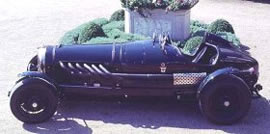 The first Bentley production
car was the 3 liter model, Ettore Bugatti
described it as the fastest Lorry in the
world...
The first Bentley production
car was the 3 liter model, Ettore Bugatti
described it as the fastest Lorry in the
world...
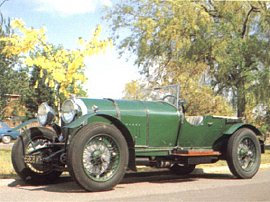 W.O. soon added
front wheel brakes, a move that would
bring much praise from commentators
of the day and quickly establish
the reputation of the marque...
W.O. soon added
front wheel brakes, a move that would
bring much praise from commentators
of the day and quickly establish
the reputation of the marque...
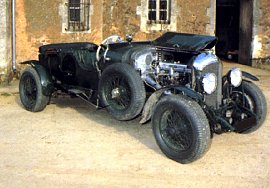 It was a more
standard 130bhp un-blown 4.5 liter
that would win the Le Mans 24 hour
in 1928 – perhaps giving away
reliability issues associated with
the supercharger...
It was a more
standard 130bhp un-blown 4.5 liter
that would win the Le Mans 24 hour
in 1928 – perhaps giving away
reliability issues associated with
the supercharger...
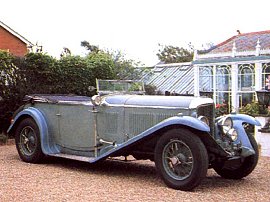 Bentley was unashamedly
targeting Rolls Royce with the 6.5
liter, hoping to enter what was at
the time referred to as the ‘carriage
trade’...
Bentley was unashamedly
targeting Rolls Royce with the 6.5
liter, hoping to enter what was at
the time referred to as the ‘carriage
trade’...
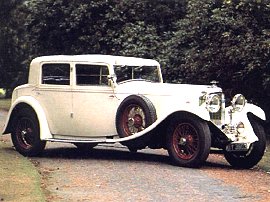 The 8 liter was
a final roll of the dice for W.O.,
hoping to lure purchasers away from
rival Rolls-Royce...
The 8 liter was
a final roll of the dice for W.O.,
hoping to lure purchasers away from
rival Rolls-Royce...
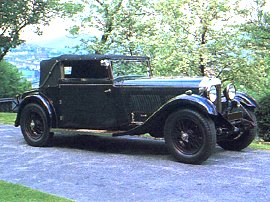 Despite beautiful
body styles such as the Vanden Plas,
the 8 liter was somewhat unrefined
when compared to the equivelant Rolls,
and a lack of sales would see the
receivers move in...
Despite beautiful
body styles such as the Vanden Plas,
the 8 liter was somewhat unrefined
when compared to the equivelant Rolls,
and a lack of sales would see the
receivers move in...
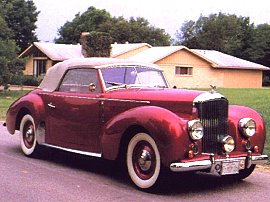 The 1951 Bentley
Mk.6 shared much with the equivelant
Rolls...
The 1951 Bentley
Mk.6 shared much with the equivelant
Rolls...
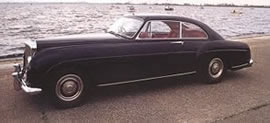 With wonderful
cars such as the Bentley Continental,
who would dare say the marque was
lost?
With wonderful
cars such as the Bentley Continental,
who would dare say the marque was
lost? |
Many of the cars that feature in the
Unique Cars and Parts “Heritage” and “Lost Marques”
articles would find their way to the race-track and
in the early part of last century there was no bigger
battle between manufacturers than that between Mercedes
and the great Bentley.
The company was founded by Walter
Owen (W.O.) Bentley, who had originally trained as an
engineer in the Great Northern Railway workshops in
Doncaster (UK); W.O. would eventually join the motor
trade in London where he would import French DFP cars.
His first design achievement was to produce light weight
aluminum pistons for the 12/40 model, allowing the engine
to rev much faster, and in turn develop more power.
W.O. then went on to become one of the key designers
of the rotary engine as used in aircraft of the time,
working with the British government during the 1914-1918
war.
In 1919 Bentley teamed up with F. T. Burgess (designer
the 1914 “TT” Humber’s) and Harry
Varley (ex-Vauxhall) with a view to creating his own
cars.
It would take nearly 2 years for development to
be completed and production to begin, but the wait was
well and truly worth it!
The first Bentley production car was the 3 liter model;
the 3 liters engine made extensive use of aluminum in
its construction, and was distinguished by the use of
a single overhead camshaft with four valves per cylinder.
Peak output was around 70bhp and the car was good for
a very respectable top speed between 70 and 80mph (112-129kmh).
The first of the 3 liters were only fitted with rear
brakes (common for cars being manufactured at the time),
however to rein in the beast W.O. soon added front wheel
brakes (1923) – a move that would bring much praise
from commentators of the day and quickly establish the
reputation of the marque.
Each and every one of the famous “W O”
Bentleys, as these cars came to be known, was developed
from this original layout.
A 4.5 liter model capable
of up to 90mph (145kmh) was announced in 1927, the increased
engine capacity obviously giving more power and torque.
This engine produced about 100bhp at first, but for
some of the select gentry able to afford a Bentley and
having the right connections it was possible to obtain
a car fitted with an engine good for 130bhp.
But there was an even better Bentley – the famous
“Blower” model of 1929. The engine had been
redesigned by Amherst Villiers following encouragement
from the racing driver Sir Henry Birkin.
W.O. himself
never liked the concept, but reluctantly allowed a few
cars to be built so that the 4.5 liter could be raced
as a 'production' car.
Interestingly, it was a more
standard 130bhp un-blown 4.5 liter that would win the
Le Mans 24 hour in 1928 – perhaps giving away
reliability issues associated with the supercharger.
Bentley decided from the outset of manufacture that
they would concentrate on construction of chassis and
engines, and would never built their own bodywork.
This
meant that some of their chassis were fitted with cumbersome,
heavy and unattractive body styles, but it also meant
that there would be a vast number of different styles
to be found behind the unmistakable Bentley radiator.
The most famous is arguably the Vanden Plas open four-seater
sports style – usually painted in British Racing
Green.
In 1925 a 6.5 liter six-cylinder engine and chassis
were developed, both being extensions of the original
design philosophy.
Bentley was unashamedly targeting
Rolls Royce with this car, hoping to enter what was
at the time referred to as the ‘carriage trade’.
But Rolls had a firm grip on the upper end of the market,
and the Bentley engineering, while excellent, was no
match for the refinement to be found in a ‘Roller’.
With considerable developmental costs attributed to
the 6.5 liter, Bentley was naturally reluctant to scrap
the concept altogether. Instead, he chose to further
develop the chassis, and so evolved the “Speed
Six” sporting chassis.
The engine was now good
for an astounding 160bhp in standard form!, and the
cars could happily cruise all day at 90mph (145kmh).
Racing versions were used by the 'works' team, where
they would take out the Le Mans classic in 1929 and
again in 1930. A “Speed Six” would also
win the Double-12 Hour race at Brooklands.
But despite these and many other racing victories,
and the associated publicity such victories were creating,
the company seemed unable to break free from financial
shackles.
Woolf Barnato moved into control of the company
in 1926, and also continued to be the most successful
and consistent of its racing drivers, who collectively
became known as the 'Bentley Boys.'
Unfortunately Barnato was not able to arrest the downward
spiral of the company’s financial fortunes, particularly
as the magnificent 8 liter model had failed to generate
sales.
In 1931 Barnato withdrew his financial support,
and the company was put into the hands of the receiver.
A sordid courtroom battle ensued; the outcome saw nominees
purchase Bentley on behalf of Rolls-Royce Ltd, who also
obtained the services of W.0. Bentley.
We can assume
W.O. was not to fond of this arrangement, for as soon
as his contractual obligations with Rolls-Royce came
to an end he joined Wilbur Gunn at Lagonda.
The famous Bentley badge would re-appear on the Rolls-Royce
designed 1933 3.5 liter “Silent Sports Car”.
The 3.5 liter featured a new chassis, and although individual
body styles were built by coachbuilders, the car featured
a much-modified Rolls-Royce 20/25 engine and transmission.
Unlike previous Bentleys the new car was rather elitist
and far from sporting.
From 1936 the car's engine capacity increased from
3669cc to 4257cc, thus creating the 4 liter model.
But
the new car did not offer any performance improvements,
although shortly before the outbreak of World War 2
an 'overdrive' was fitted allowing the cars to cruise
happily and consistently at 90mph on any of Europe’s
growing highway network.
In total approximately 2400
3.5 and 4.5 'Derby' model Bentleys were built.
Following the war, a new generation of rationalized
Bentley and Rolls-Royce cars were produced from the
new factory at Crewe, the two types of car becoming
increasingly alike. However one model, the R-Type Continental
announced in 1952, was very definitely a sporting Bentley.
Featuring rakish body lines usually crafted by H J Mulliner,
the R-Type was good for a top speed of 120mph (193kmh)
in both elegance and comfort.
Between 1952 and 1955,
208 of these cars were produced, at first with 4.25
liter overhead inlet/ side exhaust valves, later with
4566cc units, and finally from 1954, with 4887cc engines.
The second generation of postwar cars were the Rolls-Royce
“Silver Clouds” and “S-Series”
Bentleys. Continental versions were a highlight, some
having convertible coachwork, while others featured
the more 'traditional' two-door coupe style.
From the
end of 1959 all were fitted with the new light-alloy
engine. But for us the Bentley marque finished long
before the S-Series.
It is difficult to put an exact
time on it, was it when the company was purchased by
Rolls-Royce, or when W.O. left for Lagonda – or
do you think the marque lives on to this day? |
